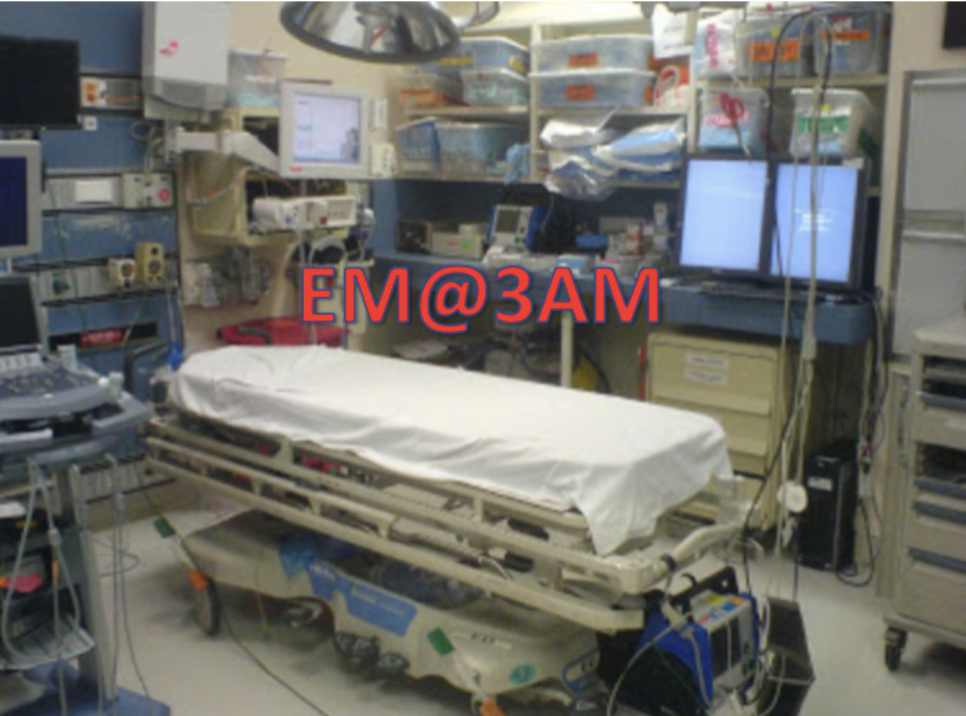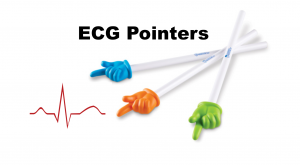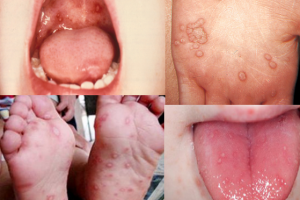Authors: Luke Colin, MD (EM Resident Physician, Mizzou – Columbia, MO); Sarah McLeod (MS-3, Mizzou – Columbia, MO); Jessica Pelletier, DO, MHPE (Assistant Professor of EM/Assistant Residency Director, Mizzou – Columbia, MO) // Reviewed by: Sophia Görgens, MD (EM Physician, BIDMC, MA); Cassandra Mackey, MD (Assistant Professor of Emergency Medicine, UMass Chan Medical School); Alex Koyfman, MD (@EMHighAK); Brit Long, MD (@long_brit)
Welcome to EM@3AM, an emDOCs series designed to foster your working knowledge by providing an expedited review of clinical basics. We’ll keep it short, while you keep that EM brain sharp.
A 24-year-old male with no significant past medical history presents with several days of oral ulcers and throat pain. He also notes multiple months of diarrhea and hematochezia. The patient was appropriately treated for H. pylori 6 months prior but was lost to follow-up. Since then, he has experienced upwards of 10 episodes of bloody diarrhea daily. He additionally reports frequent, diffuse, cramping abdominal pain that is worsened by oral intake regardless of food type (gluten, dairy, meat, etc.). The patient has lost roughly 30 lbs over the preceding 6 months. He has had worsening generalized weakness throughout this time and has recently been experiencing lightheadedness for several weeks. A few days ago, the patient developed oral sores that cause pain with swallowing.
Vital signs reveal normothermia, normotension, borderline tachycardia, O2 saturation of 100% on RA, normal respiratory rate, and a weight of 48kg.
Physical exam:
- Appears thin with dry mucous membranes
- Abdomen is soft, nondistended, and mildly tender diffusely
- Ulcers present on the uvula and soft palate
Labs: WBC 21 × 109/L, HGB 7.1 g/dL, MCV 67 fl, PLT 849,000/uL, ESR 39 mm/hour, CRP 6.4 mg/L, Na 132 mEq/L, K 2.7 mEq/L, Cr 0.5 mg/dL, BUN 6 mg/dL, calcium 7.3 mg/dL, albumin 1.6 g/dL, and total bilirubin/AST/ALT within normal limits. HIV and mononucleosis testing are negative.
What is the diagnosis?
Answer: Inflammatory Bowel Disease
Background:
- Inflammatory Bowel Disease (IBD) is characterized by a chronic inflammatory state of the gastrointestinal (GI) tract
- Includes Crohn’s disease (CD) and ulcerative colitis (UC)1
- UC classically involves the rectum and can extend proximally through the entire colon in a continuous pattern (in contrast to skip lesions seen in CD)
- Early detection and treatment are crucial for limiting the risk of life-threatening complications1

Etiology:
- The exact cause of IBD is unknown
- Current evidence suggests multifactorial pathogenesis including host microbiota imbalance, genetic susceptibility, and environmental factors3
- Gut Microbiota
- Natural gut bacteria play an important role in overall digestive function. Slight imbalances in gut flora could impair gut homeostasis and function predisposing patients to a chronic inflammatory state
- Minor changes in diet, antibiotics, probiotics, stress, surgery, and other factors can disrupt the protective intestinal mucosal barriers, altering the microbiome and predisposing the colon to chronic inflammation4
- Enteric infections, particularly Salmonella and Campylobacter species have been shown to damage mucosal barriers, alter the microbiome, and increase patient risk for developing IBD within a year of infection5
- Genetic Factors
- Environmental Factors
- Diet: Diets with high levels of saturated fats, sugars, and artificial additives are associated with both UC and CD development
- Increased fruit and vegetable consumption appears to be protective8
- Medications: Prolonged antibiotic courses, as well as daily NSAID and/or oral contraceptive use, increase lifetime risk of developing UC9
- Smoking: Has been shown to be protective against UC but increases the risk for CD
- Stress: High frequency and prolonged duration of psychological stress has been linked to earlier disease onset and faster progression of symptoms8
- Diet: Diets with high levels of saturated fats, sugars, and artificial additives are associated with both UC and CD development
Epidemiology:
- UC
- In 2023, the prevalence of UC was estimated to be 5 million cases around the world, with incidence increasing worldwide10
- The incidence of UC is 8.8-23.1 per 100,000 person-years in North America11
- UC has a higher prevalence than CD
- UC prevalence in the United States is 1.0% (95% CI 0.5,1.4%; 1.9 million persons)12
- Bimodal age distribution with the 1st peak occurring during the 2nd or 3rd decade of life, and the second peak between 50 and 80 years13
- Sex does not appear to affect the overall incidence until the age of 45, where males demonstrated a significantly higher incidence of UC compared to females of the same age14
- CD
- The annual incidence of CD in North America is 3-20 per 100,000 person years15
- Higher incidence among young adults with approximately 2/3 of patients diagnosed prior to age 40
- Patients diagnosed later than age 40 appear to have higher rates of colonic involvement11
- CD prevalence is 0.3% in the United States (95% CI 0.1,0.4%; 578,000 persons)12
- Bimodal age distribution with 1st peak between 2nd and 3rd decade of life and the second between 5th and 6th decade16
- The annual incidence of CD in North America is 3-20 per 100,000 person years15
Clinical Presentation:
- IBD presenting signs and symptoms
- Bloody diarrhea
- Colicky abdominal pain relieved by defecation
- Uveitis with associated eye pain and/or vision changes
- Oral Ulcers
- Tenesmus
- Nausea
- Fatigue
- Weight loss
- Rectal urgency8
- Joint pain
- Delayed growth in children with IBD17
- Primary sclerosing cholangitis (PSC) has been associated with IBD, particularly UC, and presents with
- Pruritus
- Jaundice
- RUQ pain
- Fatigue
- Weight loss
- Dry mouth and eyes
- Hepatosplenomegaly (progressed disease)18
- Distinguishing IBD from irritable bowel syndrome (IBS), a common mimic
- IBS can be a common mimic of IBD
- IBS diagnostic criteria per Rome IV
- Abdominal pain at least one day per week, during the previous 3 months, with at least 2 of the following
- Pain associated with bowel movements, change in stool frequency, change in stool appearance19
- Overlapping symptoms
- Recurrent abdominal pain related to defecation and/or food intake, diarrhea, nausea, and tenesmus20
- Differentiating factors
- Abdominal pain at least one day per week, during the previous 3 months, with at least 2 of the following
- IBS diagnostic criteria per Rome IV
- Physical exam
- Often unremarkable in early or mild disease; otherwise can present with:
- Vital signs: Tachycardia, fever, and possible hypertension from dehydration are common
- Abdominal tenderness, distension, guarding
- Pallor (due to anemia)
- Weight loss, malnutrition
- Occult blood on digital rectal exam
- Mucus and/or blood in stool
- In CD, abscesses, anal fistulas, or rectal prolapse may be detected on rectal exam
- Toxic megacolon can occur in both CD and UC (more commonly in severe UC) and is a surgical emergency characterized by:
- Severe abdominal pain, distension, fever, fatigue, and decreased bowel sounds22,23
- Of patients diagnosed with IBS, approximately 30% of them initially present to the ED while the majority are typically diagnosed through primary care or referred to a gastroenterologist24
- Often unremarkable in early or mild disease; otherwise can present with:
Labs:
- CBC to evaluate for leukocytosis and/or anemia
- Iron deficiency anemia common
- Thrombocytosis is also frequently observed in IBD patients
- Platelet count can directly correlate to severity of disease25
- CMP to evaluate for electrolyte abnormalities
- ESR/CRP should be obtained in suspected IBD patients29
- Stool studies should be obtained in initial workup for IBD and significant exacerbations30
- Intestinal inflammatory markers to differentiate IBD from inflammatory bowel syndrome (IBS) and monitor disease activity
- Clostridium difficile toxin testing32
- GI PCR
- Other labs to consider:
- Lactic acid
- Magnesium
- Phosphorous
- HIV (early HIV infection can present with many similarities to IBD)
- Fevers, night sweats, oral ulcers, abdominal pain, diarrhea, rash, and joint involvement
- Monospot if oral sores are present
- Anti-TTG for celiac disease as part of the initial workup30
- There should be no significant lab derangements in IBS patients, in contrast with IBD patients
Imaging:
- CT abdomen and pelvis (A/P) with contrast is recommended in these patients when there is suspicion for abscess, fistula, obstruction, perforation, acute abdomen, bleed, and/or other complications28,33
- WBC >12 is a positive predictor for clinically significant CT findings in CD and should be utilized given leukocytosis and the proper clinical scenario29
- Approximately 26% of CT scans in IBD patients identify actionable findings such as abscesses, fistulas, obstructions, and choledocholithiasis30
- CD patients with leukocytosis and previous ileal disease have clinically significant findings 47% of the time30
- Overall, 32.1% of CTs have actionable findings30
- CT scans in UC patients may be less beneficial, with 63.2% showing no significant findings and less than 2% revealing UC-related complications29
- Only 12.6% of scans show actionable results29
- POCUS has a limited role in the evaluation of IBD patients although it can be utilized to evaluate for abscesses and free fluid if CT imaging is unavailable35,36
- Imaging findings will be normal in IBS patients, helping distinguish this condition from IBD
Diagnosis:
- The following should raise suspicion for IBD
- Constellation of symptoms
- Most common:
- Diarrhea
- Hematochezia and/or stool with mucous
- Abdominal pain or cramping
- Tenesmus and urgency
- Fatigue and fevers
- Weight loss, anorexia, failure to thrive
- Fistulas, fissures, abscesses
- Extraintestinal manifestations (EIMs): arthritis, skin disorders, uveitis37,38
- Primary EIMs occur in 25-40% of IBS patients. Primary manifestations include findings involving the skin, eyes, joints, and liver
- When secondary manifestations are included (i.e., all other abnormalities outside of the GI lumen), nearly 100% of patients have at least one EIM at time of diagnosis39
- Most common:
- Lab results
- Anemia, leukocytosis, and thrombocytosis on CBC
- Electrolyte abnormalities, hypoalbuminemia, elevated LFTs, and decreased renal function
- Elevated inflammatory markers (CRP and ESR)
- Elevated fecal calprotectin/lactoferrin and exclusion of infectious causes37,38
- CT imaging revealing
- Bowel wall thickening, mural hyperenhancement, engorged vasa recta (comb sign), fat stranding, and mesenteric lymphadenopathy37,40
- Constellation of symptoms
- Definitive diagnosis
- Comprehensive approach requiring endoscopy and biopsy
- Will also help differential IBD from IBS
- Histologic evaluation of biopsy used to differentiate between CD and UC
- Magnetic resonance (MR) and CT enterography may eventually be used to assess extent of disease23
- Comprehensive approach requiring endoscopy and biopsy
Treatment:
- All patients should receive IV fluids if volume-depleted and unable to tolerate oral intake
- Electrolytes and anemia should be corrected as indicated29
- IV corticosteroids should be reserved for acute severe UC and CD flares41
- Should only be administered if recommended by GI
- Oral steroids, like prednisone, can be given for short-term outpatient management if recommended by GI42
- Special attention should be given to taper steroids appropriately for longer courses to avoid hypoadrenalism29
- Antibiotics are only required if suspected sepsis, abscess, or superimposed infections41
- Gram negative and anaerobic coverage is required (i.e., ciprofloxacin + metronidazole, piperacillin-tazobactam)41
- Pain control and antiemetics as needed
- CT A/P w/ contrast is not always required but have a low threshold for imaging in systemically unwell patients or concerned for complication
- In cases of toxic megacolon, surgery should be consulted early due to the risk of perforation and hemorrhage
- The majority of toxic megacolon cases do not improve with medical management alone and prompt surgical intervention improves mortality outcomes43
- Interventional radiology (IR) or surgical consultation may be required for management of intra-abdominal abscesses44

Disposition:
- Approximately 60% of ED visits related to IBD result in admission
- Findings that may warrant admission:
- Leukocytosis, fever, significant pain, anemia, malnourishment, AKI, or electrolyte derangements
- Any abdominal findings requiring surgical intervention, such as bowel obstruction and abscess require admission51
- Admission is highly dependent on clinical presentation and judgment, but the presence of the above findings can play a part in decision-making51
- For those tolerating oral intake and without the aforementioned abnormalities, clinicians may consider discharge after shared decision making with the patient
Prognosis:
- UC
- Extent of colitis is predictive of colectomy52
- 1-year and 5-year colectomy rates of 2% and 13% respectively52
- Estimated rate of PSC is 4%. Significantly worse prognosis with increased risk of colorectal cancer, biliary cancer, and mortality52,53
- 44% recurrence rate within the 1st year54
- 3-month and 12-month mortality rates of 0.84% and 1.01%, respectively55
- CD
- Small bowel involvement (particularly ileal), strictures, and penetrating disease have a worse prognosis with higher surgical rates53
- Roughly 1/3 of patients require hospitalization within the 1st year of diagnosis53
- 1-year and 5-year surgery rates as high as 13% and 25%, respectively52
- 50% recurrence rate within the 1st year53
- Annual mortality rate of 1.6% compared to 1% in age and sex-matched controls56
- General prognostic factors
- Young age, high CRP, and high fecal calprotectin are prognostic of severe disease53,57
Pearls:
- The combination of diarrhea, blood in stool, abdominal pain, and tenesmus should raise concern for IBD
- Weight loss and anemia should also raise suspicion
- Laboratory work-up in the ED should include inflammatory markers and stool studies
- If there is no concern for an intra-abdominal emergency, CT A/P is unnecessary and imaging work-up can be deferred to the outpatient setting
- ED care for IBD flares is mainly supportive
- Corticosteroids should be discussed with GI, and antibiotics added in patients with suspected infection

A 39-year-old woman with a history of Crohn disease presents to the emergency department with nausea, vomiting, and diffuse abdominal pain for the past 3 days. Her vital signs are a T of 99.8°F (37.7°C), BP of 100/65 mm Hg, and HR of 105 bpm. A CT scan of the abdomen and pelvis shows several dilated loops of small bowel with air-fluid levels consistent with a small bowel obstruction. Which of the following is the most appropriate treatment?
A) Admit for emergent operative intervention
B) Admit for intravenous steroids
C) Discharge with oral steroids
D) Start antibiotics
Correct answer: B
Inflammatory bowel disease and its complications may lead to bowel obstruction at various locations along the intestines. Crohn disease is a form of inflammatory bowel disease characterized by chronic recurrent inflammation of the intestines and may affect any part of the gastrointestinal tract. The bowel wall inflammation from Crohn disease leads to complications, including the formation of strictures, abscesses, and fistulae. Strictures are areas of abnormal narrowing of the intestines and can lead to bowel obstructions, which is the most common complication of Crohn disease.
Initial management for bowel obstruction due to strictures from Crohn disease is medical therapy, which often includes treatment with steroids. Intravenous steroids and hospital admission should be used in cases of moderate to severe disease. Despite the use of medical therapy, endoscopic or surgical intervention may ultimately be needed to relieve the obstruction.

While patients with Crohn disease may eventually require procedural intervention for complications such as fistulae and bowel obstructions due to stricturing, this patient does not require emergent operative intervention (A) and should be treated initially with medical management.
Patients with mild to moderate Crohn disease flares may be considered for outpatient management and discharge with oral steroids (C). However, patients with bowel obstructions should be admitted to the hospital.
Starting antibiotics (D) in the emergency department is not routinely recommended in the nonoperative management of small bowel obstructions. Patients with evidence of perforation and planned surgical exploration should receive intravenous antibiotics targeted at organisms colonizing the intestinal tract.
Further Reading:
Further FOAMed:
- https://www.emdocs.net/inflammatory-bowel-disease-emergency-department/
- https://www.emdocs.net/em3am-inflammatory-bowel-disease/
- https://www.emdocs.net/em3am-toxic-megacolon/
References:
- Fakhoury M, Negrulj R, Mooranian A, Al-Salami H. Inflammatory bowel disease: clinical aspects and treatments. J Inflamm Res. 2014;7:113-120. doi:10.2147/JIR.S65979
- Hendrickson BA, Gokhale R, Cho JH. Clinical aspects and pathophysiology of inflammatory bowel disease. Clin Microbiol Rev. 2002;15(1):79-94. doi:10.1128/CMR.15.1.79-94.2002
- Guan Q. A Comprehensive Review and Update on the Pathogenesis of Inflammatory Bowel Disease. J Immunol Res. 2019;2019:1-16. doi:10.1155/2019/7247238
- Shan Y, Lee M, Chang EB. The Gut Microbiome and Inflammatory Bowel Diseases. Annu Rev Med. 2022;73:455-468. doi:10.1146/annurev-med-042320-021020
- Gradel KO, Nielsen HL, Schønheyder HC, Ejlertsen T, Kristensen B, Nielsen H. Increased short- and long-term risk of inflammatory bowel disease after salmonella or campylobacter gastroenteritis. Gastroenterology. 2009;137(2):495-501. doi:10.1053/j.gastro.2009.04.001
- Moller FT, Andersen V, Wohlfahrt J, Jess T. Familial risk of inflammatory bowel disease: a population-based cohort study 1977-2011. Am J Gastroenterol. 2015;110(4):564-571. doi:10.1038/ajg.2015.50
- Ventham NT, Kennedy NA, Nimmo ER, Satsangi J. Beyond gene discovery in inflammatory bowel disease: the emerging role of epigenetics. Gastroenterology. 2013;145(2):293-308. doi:10.1053/j.gastro.2013.05.050
- Gajendran M, Loganathan P, Jimenez G, et al. A comprehensive review and update on ulcerative colitis,. Dis Mon. 2019;65(12):100851. doi:10.1016/j.disamonth.2019.02.004
- Ananthakrishnan AN. Epidemiology and risk factors for IBD. Nat Rev Gastroenterol Hepatol. 2015;12(4):205-217. doi:10.1038/nrgastro.2015.34
- Le Berre C, Honap S, Peyrin-Biroulet L. Ulcerative colitis. Lancet Lond Engl. 2023;402(10401):571-584. doi:10.1016/S0140-6736(23)00966-2
- Shivashankar R, Tremaine WJ, Harmsen WS, Loftus EV. Incidence and Prevalence of Crohn’s Disease and Ulcerative Colitis in Olmsted County, Minnesota From 1970 Through 2010. Clin Gastroenterol Hepatol Off Clin Pract J Am Gastroenterol Assoc. 2017;15(6):857-863. doi:10.1016/j.cgh.2016.10.039
- Weisman MH, Oleg Stens null, Seok Kim H, Hou JK, Miller FW, Dillon CF. Inflammatory Bowel Disease Prevalence: Surveillance data from the U.S. National Health and Nutrition Examination Survey. Prev Med Rep. 2023;33:102173. doi:10.1016/j.pmedr.2023.102173
- Segal JP, LeBlanc JF, Hart AL. Ulcerative colitis: an update. Clin Med. 2021;21(2):135-139. doi:10.7861/clinmed.2021-0080
- Blumenstein I, Sonnenberg E. Sex- and gender-related differences in inflammatory bowel diseases. Front Gastroenterol. 2023;2:1199687. doi:10.3389/fgstr.2023.1199687
- Feuerstein JD, Cheifetz AS. Crohn Disease: Epidemiology, Diagnosis, and Management. Mayo Clin Proc. 2017;92(7):1088-1103. doi:10.1016/j.mayocp.2017.04.010
- Polito J, Childs B, Mellits E, Tokayer A, Harris M, Bayless T. Crohn’s disease: Influence of age at diagnosis on site and clinical type of disease. Gastroenterology. 1996;111(3):580-586. doi:10.1053/gast.1996.v111.pm8780560
- Wong K, Isaac DM, Wine E. Growth Delay in Inflammatory Bowel Diseases: Significance, Causes, and Management. Dig Dis Sci. 2021;66(4):954-964. doi:10.1007/s10620-020-06759-5
- Williamson KD, Chapman RW. Primary sclerosing cholangitis. Dig Dis Basel Switz. 2014;32(4):438-445. doi:10.1159/000358150
- Schmulson MJ, Drossman DA. What Is New in Rome IV. J Neurogastroenterol Motil. 2017;23(2):151-163. doi:10.5056/jnm16214
- Bhinder G, Meza-Cardona JM, Low A, Aumais G, Attara GP, Gray JR. Irritable Bowel Syndrome Patient Experience: A Survey of Patient-Reported Symptoms by Irritable Bowel Syndrome Subtype and Impact on Quality of Life. J Can Assoc Gastroenterol. 2023;6(6):219-228. doi:10.1093/jcag/gwad028
- Vich Vila A, Imhann F, Collij V, et al. Gut microbiota composition and functional changes in inflammatory bowel disease and irritable bowel syndrome. Sci Transl Med. 2018;10(472):eaap8914. doi:10.1126/scitranslmed.aap8914
- Matsuoka K, Kobayashi T, Ueno F, et al. Evidence-based clinical practice guidelines for inflammatory bowel disease. J Gastroenterol. 2018;53(3):305-353. doi:10.1007/s00535-018-1439-1
- Flynn S, Eisenstein S. Inflammatory Bowel Disease Presentation and Diagnosis. Surg Clin North Am. 2019;99(6):1051-1062. doi:10.1016/j.suc.2019.08.001
- Sabaté JM, Rivière S, Jouet P, Gastaldi-Menager C, Fagot-Campagna A, Tuppin P. Healthcare use by 30,000 patients with irritable bowel syndrome (IBS) in France: a 5-year retrospective and one-year prospective national observational study. BMC Gastroenterol. 2019;19(1):111. doi:10.1186/s12876-019-1031-z
- Tibble J, Teahon K, Thjodleifsson B, et al. A simple method for assessing intestinal inflammation in Crohn’s disease. Gut. 2000;47(4):506-513. doi:10.1136/gut.47.4.506
- Restellini S, Chazouillères O, Frossard J. Hepatic manifestations of inflammatory bowel diseases. Liver Int. 2017;37(4):475-489. doi:10.1111/liv.13265
- Lewis B, Mukewar S, Lopez R, Brzezinski A, Hall P, Shen B. Frequency and Risk Factors of Renal Insufficiency in Inflammatory Bowel Disease Inpatients: Inflamm Bowel Dis. Published online May 2013:1. doi:10.1097/MIB.0b013e31828a661e
- Abreu MT, Harpaz N. Diagnosis of Colitis: Making the Initial Diagnosis. Clin Gastroenterol Hepatol. 2007;5(3):295-301. doi:10.1016/j.cgh.2006.12.032
- Koliani-Pace J, Vaughn B, Herzig SJ, et al. Utility of Emergency Department Use of Abdominal Pelvic Computed Tomography in the Management of Crohn’s Disease. J Clin Gastroenterol. 2016;50(10):859-864. doi:10.1097/MCG.0000000000000508
- Gashin L, Villafuerte-Galvez J, Leffler DA, Obuch J, Cheifetz AS. Utility of CT in the Emergency Department in Patients with Ulcerative Colitis: Inflamm Bowel Dis. 2015;21(4):793-800. doi:10.1097/MIB.0000000000000321
- Lichtenstein GR, Loftus EV, Isaacs KL, Regueiro MD, Gerson LB, Sands BE. ACG Clinical Guideline: Management of Crohn’s Disease in Adults. Am J Gastroenterol. 2018;113(4):481-517. doi:10.1038/ajg.2018.27
- Negrón ME, Rezaie A, Barkema HW, et al. Ulcerative Colitis Patients With Clostridium difficile are at Increased Risk of Death, Colectomy, and Postoperative Complications: A Population-Based Inception Cohort Study. Am J Gastroenterol. 2016;111(5):691-704. doi:10.1038/ajg.2016.106
- Yarur AJ, Mandalia AB, Dauer RM, et al. Predictive factors for clinically actionable computed tomography findings in inflammatory bowel disease patients seen in the emergency department with acute gastrointestinal symptoms. J Crohns Colitis. 2014;8(6):504-512. doi:10.1016/j.crohns.2013.11.003
- Kornbluth A, Sachar DB. Ulcerative Colitis Practice Guidelines in Adults: American College of Gastroenterology, Practice Parameters Committee. Am J Gastroenterol. 2010;105(3):501-523. doi:10.1038/ajg.2009.727
- Bots S, De Voogd F, De Jong M, et al. Point-of-care Intestinal Ultrasound in IBD Patients: Disease Management and Diagnostic Yield in a Real-world Cohort and Proposal of a Point-of-care Algorithm. J Crohns Colitis. 2022;16(4):606-615. doi:10.1093/ecco-jcc/jjab175
- Chavannes M, Dolinger MT, Cohen-Mekelburg S, Abraham B. AGA Clinical Practice Update on the Role of Intestinal Ultrasound in Inflammatory Bowel Disease: Commentary. Clin Gastroenterol Hepatol. 2024;22(9):1790-1795.e1. doi:10.1016/j.cgh.2024.04.039
- Choi D, Jin Lee S, Ah Cho Y, et al. Bowel Wall Thickening in Patients with Crohn’s Disease: CT Patterns and Correlation with Inflammatory Activity. Clin Radiol. 2003;58(1):68-74. doi:10.1053/crad.2002.1068
- Del Campo L, Arribas I, Valbuena M, Maté J, Moreno-Otero R. Spiral CT Findings in Active and Remission Phases in Patients with Crohn Disease: J Comput Assist Tomogr. 2001;25(5):792-797. doi:10.1097/00004728-200109000-00020
- Levine JS, Burakoff R. Extraintestinal manifestations of inflammatory bowel disease. Gastroenterol Hepatol. 2011;7(4):235-241.
- Plastaras L, Vuitton L, Badet N, Koch S, Di Martino V, Delabrousse E. Acute colitis: differential diagnosis using multidetector CT. Clin Radiol. 2015;70(3):262-269. doi:10.1016/j.crad.2014.11.008
- Thia KT, Mahadevan U, Feagan BG, et al. Ciprofloxacin or metronidazole for the treatment of perianal fistulas in patients with Crohnʼs disease: A randomized, double-blind, placebo-controlled pilot study: Inflamm Bowel Dis. 2009;15(1):17-24. doi:10.1002/ibd.20608
- Schauer C, Avery V, Seleq S, et al. A comparison of intravenous methylprednisolone and hydrocortisone for the treatment of acute inflammatory bowel disease. J Gastroenterol Hepatol. 2021;36(10):2762-2768. doi:10.1111/jgh.15535
- Heppell J, Farkouh E, Dubé S, Péloquin A, Morgan S, Bernard D. Toxic megacolon: An analysis of 70 cases. Dis Colon Rectum. 1986;29(12):789-792. doi:10.1007/BF02555345
- Vora R, Finnamore HE, Crook K, et al. Clinical Experience of Use of High‐dose Intravenous Methylprednisolone in Children With Acute Moderate to Severe Colitis. J Pediatr Gastroenterol Nutr. 2016;63(1):51-57. doi:10.1097/MPG.0000000000001080
- Evans L, Rhodes A, Alhazzani W, et al. Surviving Sepsis Campaign: International Guidelines for Management of Sepsis and Septic Shock 2021. Crit Care Med. 2021;49(11):e1063-e1143. doi:10.1097/CCM.0000000000005337
- De Simone B, Davies J, Chouillard E, et al. WSES-AAST guidelines: management of inflammatory bowel disease in the emergency setting. World J Emerg Surg. 2021;16(1):23. doi:10.1186/s13017-021-00362-3
- Liggett MR, Alam HB. Management of Severe Colitis and Toxic Megacolon. Clin Colon Rectal Surg. 2024;37(6):404-410. doi:10.1055/s-0043-1777665
- Micromedex. Meropenem. In: ; 2025. Accessed February 19, 2025. https://www.micromedexsolutions.com/micromedex2/librarian/PFDefaultActionId/evidencexpert.DoIntegratedSearch?navitem=headerLogout#
- Micromedex. Ceftriaxone. In: ; 2025. Accessed February 19, 2025. https://www.micromedexsolutions.com/micromedex2/librarian/PFDefaultActionId/evidencexpert.DoIntegratedSearch?navitem=topHome&isToolPage=true#
- Micromedex. Piperacillin sodium/Tazobactam Sodium. In: ; 2025. Accessed February 19, 2025. https://www.micromedexsolutions.com/micromedex2/librarian/CS/64A3FF/ND_PR/evidencexpert/ND_P/evidencexpert/DUPLICATIONSHIELDSYNC/55F5EC/ND_PG/evidencexpert/ND_B/evidencexpert/ND_AppProduct/evidencexpert/ND_T/evidencexpert/PFActionId/evidencexpert.IntermediateToDocumentLink?docId=1457&contentSetId=31&title=PIPERACILLIN+SODIUM%2FTAZOBACTAM+SODIUM&servicesTitle=PIPERACILLIN+SODIUM%2FTAZOBACTAM+SODIUM#
- Gajendran M, Umapathy C, Loganathan P, Hashash JG, Koutroubakis IE, Binion DG. Analysis of Hospital-Based Emergency Department Visits for Inflammatory Bowel Disease in the USA. Dig Dis Sci. 2016;61(2):389-399. doi:10.1007/s10620-015-3895-2
- Niewiadomski O, Studd C, Hair C, et al. Prospective population‐based cohort of inflammatory bowel disease in the biologics era: Disease course and predictors of severity. J Gastroenterol Hepatol. 2015;30(9):1346-1353. doi:10.1111/jgh.12967
- Ye BD, Yang SK, Boo SJ, et al. Clinical characteristics of ulcerative colitis associated with primary sclerosing cholangitis in Korea: Inflamm Bowel Dis. 2011;17(9):1901-1906. doi:10.1002/ibd.21569
- Romberg-Camps MJL, Dagnelie PC, Kester ADM, et al. Influence of Phenotype at Diagnosis and of Other Potential Prognostic Factors on the Course of Inflammatory Bowel Disease. Am J Gastroenterol. 2009;104(2):371-383. doi:10.1038/ajg.2008.38
- Dong C, Metzger M, Holsbø E, Perduca V, Carbonnel F. Systematic review with meta‐analysis: mortality in acute severe ulcerative colitis. Aliment Pharmacol Ther. 2020;51(1):8-33. doi:10.1111/apt.15592
- Loftus EV. Crohn’s disease: why the disparity in mortality? Gut. 2006;55(4):447-449. doi:10.1136/gut.2005.080283
- Han IS, Baek DH, Hong SM, et al. Incidence and adverse clinical events of primary sclerosing cholangitis with ulcerative colitis. Int J Colorectal Dis. 2023;38(1):175. doi:10.1007/s00384-023-04464-z






